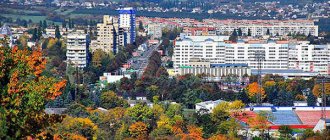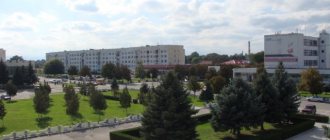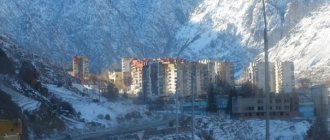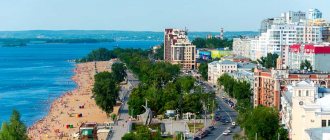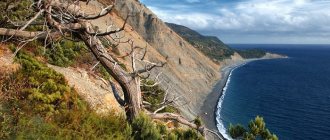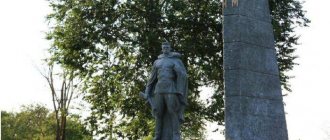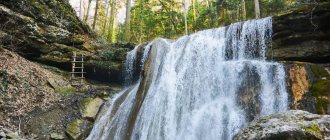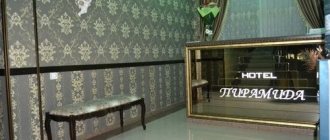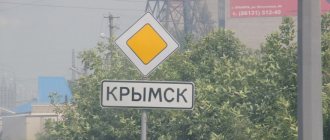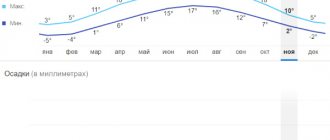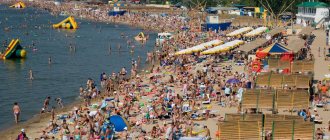Tatyana Afanasyeva
Arriving in Minvody, we rented a car and drove 1257 km in Stavropol, Karachay-Cherkessia and Kabardino-Balkaria. If you missed the beginning of the series, everything is in the links, and we move on.
If you missed the beginning of the series, everything is in the links, and we move on.
Part 1. Departure from Kaluga, domestic car rental, Bermamyt and Kislovodsk. Part 2. Dombay, the Devil's Mill, the site of Pechorin's duel and the climbers' cemetery.
Part 3. Djily-Su, Narzan Valley and abandoned castle
— Let me remind you what the entire route looked like.
The importance of the city in the modern world
Chegem is located in the central part of the Kabardino-Balkarian Republic, just 3 km from the capital - Nalchik, being, in fact, its suburb. It received its name from the name of the river on the right bank of which it is located.
On the other bank there is a village called “Chegem the Second”, which has an independent status, but is in fact a continuation of “Chegem the First”: they have a common border running along the river, and a common history of education and development. 40 km from Chegem, in the valley of the Chegem Gorge there is the village of “Chegem Nizhny”, and in the mountains, at an altitude of 1.7 km - “Chegem Upper”.
All Chegems are connected among themselves not only by a mountain river formed in the glaciers of the North Caucasus. Geographically, they belong to the Chegem region of the republic and are a tourism and recreation area for residents and guests of Kabardino-Balkaria.
People have settled at the foot of the mountains since very ancient times. Burial sites in the form of burial mounds and archaeological artifacts found in abundance on the Chegem River are confidently attributed by experts to the 14th-16th centuries. The settlement, which became the regional center, appeared a little later.
Its founder is considered to be the former serf Islam Mambetov, who received his freedom from the commander of the Russian troops in the Caucasus, Alexei Petrovich Ermolov, who built many fortresses in these places, including Nalchik. Mambetov continued his service, being an assistant to the Kundetov princes, the owners of this land.
As a sign of encouragement, the princes allocated him a plot of land on the right bank, where Islam built a house for himself and moved his entire family to live. The new village, which appeared in 1822, was named according to local custom after the prince-owner - Kundetov. It became Chegem after the revolution, renamed in 1920 as the bearer of the princely name.
During the Second World War, the village was in the hands of the Nazis for 3 months; it was liberated simultaneously with Nalchik in January 1943. The city honors and remembers the names of the victims. Chegem First became a city only in 2000, its area is 73 km2, and its coordinates are 43°34′00″ N. w. 43°35′00″ E. d.
Chegem Gorge
So, 1.5 hours after departure, our cheerful “gazelle” reached the flat Chegem, from where there was another half hour of road to the Chegem waterfalls.
Before entering the Chegem Gorge, the gazelle left us at a very nice cafe and we went on foot to the waterfalls. The road to the Small Chegemsky Waterfall was either washed out or under a mudflow, and at that time visiting it was closed to tourists.
The Chegem Gorge is a canyon in the Chegem Gorge about 3 kilometers long.
A few meters later, in the gorge, the face of Soslan’s sledge opens.
To the right below flows its muddy waters the Chegem River. By the way, “Chegem” translated means “the earth is cracked,” which is very typical for this place.
The 99th Lada rushes past and stops in a pocket on the side of the road. Two teenagers of local appearance come out of it, one of whom for some reason dances something like a Lezginka barefoot right on the roof of the car.
We reached the first waterfall in the Chegem Gorge - pictured below.
The next photo shows the place where the filming of the film “Sannikov Land” took place.
Chegem Gorge - at its narrowest point the width of the gorge is only 25 meters.
Rocks hang on all sides reaching a height of 300 meters.
Here, at the turn, the Chegem Gorge widens slightly and at half past 5 in the evening direct sunlight still penetrates here.
And here, in the Chegem Gorge, in the rock opposite the road, across the river, is the imprint of a sledge’s foot. Even in the photo you can see the scale of the “foot”
We cross the bridge over the Chegem River.
Climate
In the Chegem region, the climate is not the same everywhere; it is determined, first of all, by the terrain and depends on the altitude above sea level. Chegem is a city that is located in the foothill zone and has typical climatic conditions: there are no strong winds, daily fluctuations in air temperature are significant, its average annual value is + 9.5 0C.
Spring comes early and quickly turns into summer; already in mid-April the thermometer can show 30 degrees. Summer is hot and lasts until the end of September; light breezes from the mountains bring relief from the heat. Autumn is long, warm and dry. Winter is mild, almost snowless.
Chegem, weather by month.
Daily air temperature (0C), precipitation (mm), number of sunny days in Chegem:
| Jan. | Feb. | March | Apr. | May | June | July | Aug. | Sep. | Oct. | Nov. | Dec. |
| -3 | +3 | +12 | +14 | +22 | +26 | +28 | +29 | +20 | +11 | +6 | +3 |
| 15 | 9 | 36 | 46 | 111 | 133 | 95 | 70 | 56 | 25 | 20 | 25 |
| 16 | 15 | 15 | 17 | 22 | 22 | 22 | 23 | 21 | 21 | 20 | 20 |
Lower and Upper Chegem are areas of tourist travel. They are distinguished by a mountainous climate, becoming increasingly harsh as they rise in altitude. On the peaks of the Rocky Range there is eternal snow with glaciers.
Paragliding
The mountain parade deserves special attention. The paragliding site is located 17 km from the waterfalls. It is surrounded on all sides by mountains, which creates optimal weather conditions for a comfortable flight. From the end of March to November, in clear weather, dozens of extreme sports enthusiasts flock to the parade ground. For them there is a very comfortable campsite with a kitchen, bathhouse, cafe and other amenities.
Even if you don't want to take off, this place is worth a visit just for the beautiful spectacle. Paragliders soaring at dizzying heights against the backdrop of stunning mountains will remain a pleasant and romantic memory.
© Natalia Semchina
Flora and fauna
The flora and fauna of the surrounding area of Chegem corresponds to the diversity of landscapes. Mountain rivers, descending from glaciers, feed alpine meadows and agricultural lands. The herbs of the meadows are not only decoration, they are pastures for livestock, which are raised here for domestic consumption and export.
The mountain slopes and foothills are the territory of forests, consisting mainly of beech and hornbeam. The unique natural conditions made it possible for plants that can only be found in these places to take root here. The high-mountainous Kabardino-Balkarian Nature Reserve, home to more than 300 species of birds and 60 species of amphibians, is engaged in the protection and conservation of local flora and fauna.
How to get there
The main mode of transport in the republic is automobile. The federal highway R-217 “Caucasus” passes through Chegem, connecting the city with all Caucasian and Russian settlements.
Chegem and Nalchik, located 3 km from each other, are connected by 5 public transport routes. Passenger minibuses "Gazelle" ply along them. Their opening hours are from 6-00 to 23-30.
The capital of the republic is a transport hub connecting Kabardino-Balkaria with cities in Russia and abroad. Every day, the Elbrus train departs from Paveletsky Station in Moscow to Nalchik, arriving at the final station after 36 hours. Ticket price – from 3 thousand rubles. (if purchased early).
Along the way, the train makes many stops, including:
- Lipetsk;
- Voronezh;
- Rossoshi;
- Rostov-on-Don;
- Mineral waters.
Electric trains run to the cities of Prokhladny (junction station) and Mineralnye Vody. Nalchik International Airport receives regular flights from Moscow and St. Petersburg, where planes and Pobeda fly. Travel time is 2.5 hours, ticket price is from 2,700 rubles.
Gorge
From the Chegem waterfalls it’s almost an hour’s drive to the upper reaches of the gorge, to Upper Chegem. Beyond the gorge, where the Chegem waterfalls are located, the gorge widens, forming more gentle slopes. The road goes along the left bank of the Chegem and soon reaches an area called Ak-toprak (from Balkar - White clay).
There are simply stunning views through the windshield ahead, but there is no way to take a photo. You have to catch rare moments of beauty on the starboard side.
The weather in the Chegem Gorge is slowly deteriorating, the sky is getting darker. Korgashiklitau (3813 m.) all in the clouds.
Religious buildings of the city and surrounding areas
Mosque of the city of Chegem, located at the address: st. Lenina, 42, is currently under reconstruction. Another one is on the same street, at house 161. Many religious citizens visit Nalchik mosques.
Central Mosque of Kabardino-Balkaria (Nalchik)
The Nalchik Cathedral Mosque is located on Shogentsukov Avenue, 41. Its opening took place in 2004, construction work lasted 4 years. The project by architect A. Asanov was rated as the best in a competition organized by the city authorities. Local materials were widely used in the decoration of the building. The height of the single-dome structure is 21 m, the total area is 1700 m2.
Two tall minaret towers complete the complex.
The building has two floors: the first is square in plan. There are wardrobes, ablution rooms, and separate halls for men and women; in the far corner is the women's prayer hall. The second floor, built in the shape of an octagon, is a prayer hall for men. The presence of two entrances, for parishioners and clergy, also corresponds to the canons of Islam.
Museums
Chegem is a city with one museum. Everyone is willingly invited here to get acquainted with the life and work of the famous fellow villager. Tourists seeking to gain more knowledge about the republic visit Nalchik museums.
Memorial House-Museum of Kaisyn Shuvaevich Kuliev (Chegem)
Every day in Chegem on K. Kuliev Street, 21, except Sunday and Monday, there is a museum of the Balkar poet, who lived in the house where the exhibition is displayed today. He spent the last period of his life here, wrote many works, many of which he dedicated to the Caucasus and its inhabitants. Here the poet died, bequeathing to bury himself near his beloved house.
His grave is located on the territory of the museum. The first half of the exhibition tells in chronological order about the events in the life of K.Sh. Kulieva, the second - demonstrates the furnishings of the last years of his life: office, bedroom, living room, outbuilding. The creation of the exhibition involves the poet’s personal belongings, his books, manuscripts, and photographs.
National Museum of the Kabardino-Balkarian Republic (Nalchik)
The museum, where visitors learn everything about the geographical location, terrain, mining in the republic, as well as its flora and fauna, has been operating since 1921. Much attention is paid here to the history of indigenous peoples, their culture, traditions, and ethnography.
Today, museum workers have a fund of 50 thousand items at their disposal. storage, with the help of which permanent exhibitions and temporary exhibitions are created. Museum address: st. Gorkogo, 62. Ticket price – 50 rubles.
Upper Chegem
Balkar name: Ogary Chegem
Geographical location
Upper Chegem occupies both banks of the Chegem River in its upper reaches, in the southwest of the Chegem region. Nearest settlements: Khushto-Syrt, Bezengi.
Historical reference
Upper Chegem has a history going back centuries. Here was the administrative center of the Chegem Mountain Society, the territory of which covered the Chegem and part of the Baksan gorges.
According to legend, the ancestors of the last dynasty of Chegem rulers were two brothers Baymurza and Dzhanmurza. From whom came the Balkarukovs, Kelemetovs, Barasbievs and Kuchukovs, whose ancestors took away power from the descendants of Berdy-biy, the Rachykaovs.
Thus, until the beginning of the 20th century. power belonged to the Balkarukovs, Kuchukovs, Kelemetovs, Barasbievs. But in the 1920s, as representatives of the upper class, they were subjected to repression and were evicted outside Balkaria.
In 1927, the Village Council of Upper Chegem included the following villages: Achi, Kyam, Bulungu, Dumala, Orsundak, Susuzlar, El-tyubyu, Kyoktash, Aktoprak, Zhuuungu, Bopu, Khasty-Gestanty, Ilichiri, Tuzulgu, Bykmylgy N., Bykmylgy V., Zhora, Gudyurgu, Tyzgy, Kala, Beturgu, Kyrs-Kam.
In the 1930-40s, 3 village councils were formed on the territory of the former Upper Chegem society.
Thought: Thought, Achi. Bulungu: Bulungu, Kunlyum, Orsundak, Kam. El-Tyuby: El-Tyuby, Zharilgi, Suusuzla, Bykmylgy, Ilichiri, Tuzulgu, Lubarda.
The remaining villages went to Aktoprak and Bylym.
In 1944, the residents of these villages, along with the entire people, were deported.
Those who returned back in 1957 found ashes in the place of their houses and began to build everything anew.
A collective farm named after Kalabekov was organized in the villages of Bulungu and El-Tyuby. Sarbashev Salakh Shaukhalovich was elected its chairman. A school, houses, and roads to all large and small areas were built.
In 2000, the villages of Bulungu and Verkhniy Chegem (El-Tyuby) were united into one municipal entity - the rural settlement of Verkhne-Chegemskoye, with the administrative center in the village of Bulungu.
From the settlements that existed before the deportation, Upper Chegem (El-Tubyu), Bulungu, Orsundak and Kam have now been revived, the last two as neighborhoods of the village of Bulungu.
Education
The first primary school was opened in Bulungu in 1925, followed by a seven-year school in 1931. They functioned until 1944.
During the absence of the Balkars, the schools were destroyed, so the children of the Chegemians who arrived in 1957 studied in the private house of Makitov Daut, and then in the village club. Later, a primary school was restored in El-Tubyu, and an eight-year school in Bulungu. Ataev Buzzhigit Alikoevich was appointed director. The teachers were: Akkizova Aishat Acheevna, Chipchikova Zainaf Kanalievna, Zharashuev Mazhit Magomedovich, Appaev Kasym Yusupovich, Barazova Vera Sufyanovna.
In 1996, a new school was opened, in the building of which there is also a kindergarten “Zhulduzchuk”.
Religion
There are two mosques on the territory of the rural settlement.
Surnames
Upper Chegem
For 1905
A total of 119 families lived
Agaevs Aitekovs Akbulatovs Albotovs Anakhaevs Appaevs Balkarokovs Barazbievs Bapinaevs Bashtakovs Bauchievs Bekkievs Biryukaevs Gaboevs Gazaevs Gegraevs Guduevs Dazhievs Dunduevs Zhantuduevs Idrisovs Kozhakovs Kelemetovs Kudaevs Kulievs Kuchukovs Lapaevs Maharaevs Makhievs Mula Khanovs Muratbievs Murzaevs Mushkaevs Mirzoevs Orazaevs Sarbashevs Sottayevs Sundukovs Tauchievs Teppevs Tottaevs Tuduevs Uzdenovs Khalimovs Khadzharovs Khulaevs Khurtuevs Chemaevs Chekkeevs Chepkenchievs Cherkesovs Chomartovs Shavaevs Shakhmurzaevs Edokovs Eneevs
For 1944
| Eltuby | ||||||||
| Item no. | Surname | Quantity | Were in the Red Army | Didn't return from the war | Alive by 1957 | Died by 1957 | Died before eviction | |
| families | Human | |||||||
| 1 | 2 | 3 | 4 | 5 | 6 | 7 | 8 | 9 |
| 1 | Agerjanovs | 1 | 2 | 0 | 0 | 1 | 1 | 0 |
| 2 | Aitekovs | 3 | 19 | 0 | 0 | 14 | 5 | 0 |
| 3 | Akbulatovs | 1 | 5 | 0 | 0 | 5 | 0 | 0 |
| 4 | Akkaevs | 1 | 2 | 0 | 0 | 1 | 1 | 0 |
| 5 | Albotovs | 2 | 9 | 1 | 1 | 4 | 4 | 0 |
| 6 | Anaevs | 1 | 2 | 0 | 0 | — | — | 0 |
| 7 | Appaevs | 1 | 5 | 0 | 0 | 3 | 1 | 0 |
| 8 | Atanovy | 4 | 20 | 3 | 2 | 15 | 3 | 0 |
| 9 | Akhkubekovs | 1 | 11 | 1 | 1 | 8 | 2 | 0 |
| 10 | Akhmetovs | 1 | 4 | 3 | 3 | 1 | 0 | 0 |
| 11 | Bapinaevs | 7 | 39 | 4 | 2 | 32 | 4 | 0 |
| 12 | Beshtashevs | 2 | 13 | 3 | 3 | 8 | 2 | 0 |
| 13 | Gazaevs | 9 | 34 | 4 | 4 | 15 | 10 | 0 |
| 14 | Gegraevs | 12 | 53 | 6 | 3 | 38 | 10 | 0 |
| 15 | Gemuevs | 1 | 3 | 0 | 0 | 2 | 1 | 0 |
| 16 | Donduevs | 2 | 9 | 2 | 2 | 7 | 0 | 0 |
| 17 | Zhanataevs | 3 | 15 | 1 | 1 | 10 | 4 | 0 |
| 18 | Zhantuduevs | 3 | 12 | 0 | 0 | 9 | 3 | 0 |
| 19 | Karakizovs | 1 | 7 | 0 | 0 | 6 | 1 | 0 |
| 20 | Kepemetovs | 1 | 8 | 1 | 0 | 7 | 1 | 0 |
| 21 | Kudaevs | 6 | 15 | 6 | 4 | 9 | 2 | 0 |
| 22 | Kulievs | 13 | 51 | 5 | 4 | 23 | 7 | 0 |
| 23 | Kuchmezovs | 1 | 1 | 0 | 0 | — | — | 0 |
| 24 | Lagievs | 1 | 1 | 0 | 0 | 1 | 0 | 0 |
| 25 | Maharayevs | 2 | 6 | 2 | 2 | 1 | 3 | 0 |
| 26 | Makhievs | 1 | 1 | 0 | 0 | 0 | 1 | 0 |
| 27 | Mirzoevs | 9 | 33 | 8 | 4 | 13 | 7 | 0 |
| 28 | Murnaevs | 1 | 1 | 0 | 0 | — | — | 0 |
| 29 | Mushkaevs | 1 | 1 | 1 | 0 | 1 | 0 | 0 |
| 30 | Sarbashevs | 1 | 2 | 0 | 0 | 0 | 2 | 0 |
| 31 | Suyyundukovs | 1 | 2 | 0 | 0 | 1 | 1 | 0 |
| 32 | Tattaevs | 2 | 5 | 0 | 0 | 3 | 2 | 0 |
| 33 | Teberdievs | 1 | 1 | 0 | 0 | 1 | 0 | 0 |
| 34 | Teppeevs | 1 | 5 | 1 | 1 | 3 | 1 | 0 |
| 35 | Khabichevs | 2 | 12 | 2 | 2 | 8 | 2 | 0 |
| 36 | Khazharovs | 2 | 7 | 0 | 0 | 1 | 5 | 1 |
| 37 | Kholaevs | 1 | 4 | 0 | 0 | 3 | 1 | 0 |
| 38 | Chimaevs | 2 | 7 | 0 | 0 | 2 | 2 | 0 |
| 39 | Shavaevs | 3 | 13 | 2 | 2 | 8 | 3 | 0 |
| 40 | Shakhmurzaevs | 3 | 11 | 0 | 0 | 9 | 2 | 0 |
| 41 | Edokovs | 1 | 2 | 0 | 0 | 1 | 1 | 0 |
| 42 | Eneevs | 1 | 5 | 0 | 0 | 4 | 1 | 0 |
| 43 | Etteevs | 1 | 3 | 0 | 0 | 2 | 1 | 0 |
| 44 | Total | 114 | 461 | 56 | 41 | 280 | 97 | 1 |
For 2014
village of Upper Chegem / El-Tyuby
The number of people according to the latest census is 299 people. National composition: Balkars, Germans, Russians. There are 62 yards in total.
| Agayevs | 4 families |
| Akkaevs | 1 family |
| Appaevs | 2 families |
| Akhkubekovs | 3 families |
| Albotovs | 3 families |
| Aitekovs | 5 families |
| Bashtakovs | 4 families |
| Bapinaevs | 7 families |
| Gazaevs | 1 family |
| Gegraevs | 2 families |
| Donduevs | 3 families |
| Zharashuevs | 1 family |
| Zhantuduevs | 3 families |
| Isyrovs | 1 family |
| Kudaevs | 3 families |
| Keremetovs | 4 families |
| Kalabekovs | 5 families |
| Kerimovs | 1 family |
| Mushkaevs | 2 families |
| Mirzoevs | 3 families |
| Otarovs | 1 family |
| Sarbashevs | 1 family |
| Sozaevs | 1 family |
| Stepantsovs | 1 family |
| Teppeevs | 1 family |
| Tattaevs | 1 family |
| Tatchaevs | 1 family |
| Tarasenko | 1 family |
| Khasanovs | 1 family |
| Khachaevs | 1 family |
| Shakhmurzaevs | 1 family |
Bulungu
For 1905
Appaevs Akayevs Atakuevs Akhkobekovs Bolluevs Getuevs Zhanataevs Zharashuevs Kulievs Ketenchievs Kuchmenovs Makaevs Sarbashevs Sotaevs Suyumbayevs Tappaskhanovs Chemaevs Chipchikovs Shavaevs Etezovs
For 1944
| Bulungu | ||||||||
| Item no. | Surname | Quantity | Were in the Red Army | Didn't return from the war | Alive by 1957 | Died by 1957 | Died before eviction | |
| families | Human | |||||||
| 1 | 2 | 3 | 4 | 5 | 6 | 7 | 8 | 9 |
| 1 | Aitekovs | 1 | 5 | 1 | 0 | 3 | 2 | 0 |
| 2 | Akayevs | 22 | 77 | 10 | 9 | 33 | 25 | 0 |
| 3 | Akkaevs | 1 | 3 | 1 | 1 | 0 | 2 | 0 |
| 4 | Akkizovs | 4 | 15 | 2 | 2 | 11 | 2 | 0 |
| 5 | Albotovs | 1 | 3 | 0 | 0 | 1 | — | 0 |
| 6 | Anaevs | 1 | 4 | 0 | 0 | 4 | 0 | 0 |
| 7 | Appaevs | 21 | 64 | 9 | 9 | 32 | 21 | 0 |
| 8 | Atakuevs | 6 | 23 | 1 | 0 | 12 | 10 | 0 |
| 9 | Attaevs | 1 | 1 | 0 | 0 | 0 | 1 | 0 |
| 10 | Baysultanovs | 8 | 29 | 2 | 1 | 26 | 1 | 0 |
| 11 | Barazbievs | 1 | 1 | 1 | 1 | 0 | 0 | 0 |
| 12 | Barazovs | 1 | 3 | 1 | 1 | 2 | 0 | 0 |
| 13 | Bozievs | 1 | 1 | 0 | 0 | 0 | 1 | 0 |
| 14 | Gettuevs | 2 | 8 | 2 | 2 | 4 | 2 | 0 |
| 15 | Gyllyevs | 1 | 4 | 0 | 0 | 4 | 0 | 0 |
| 16 | Zhanataevs | 2 | 3 | 1 | 1 | 1 | 1 | 0 |
| 17 | Zharashuevs | 14 | 47 | 8 | 6 | 25 | 16 | 0 |
| 18 | Zhekiraevs | 1 | 1 | 0 | 0 | — | — | 0 |
| 19 | Kamievs | 1 | 1 | 0 | 0 | — | — | 0 |
| 20 | Kankulovs | 1 | 4 | 0 | 0 | — | — | 0 |
| 21 | Ketenchievs | 6 | 26 | 4 | 3 | 11 | 7 | 0 |
| 22 | Konakovs | 1 | 4 | 0 | 0 | 2 | 2 | 0 |
| 23 | Kudaevs | 1 | 1 | 0 | 0 | — | — | 0 |
| 24 | Kulievs | 21 | 84 | 10 | 7 | 40 | 20 | 0 |
| 25 | Lagievs | 2 | 7 | 3 | 2 | 5 | 0 | 0 |
| 26 | Makitovs | 15 | 66 | 12 | 12 | 37 | 17 | 0 |
| 27 | Makkaevs | 1 | 2 | 0 | 0 | 2 | 0 | 0 |
| 28 | Sarbashevs | 17 | 89 | 2 | 0 | 67 | 19 | 0 |
| 29 | Suyunbaevs | 1 | 2 | 0 | 0 | 0 | 2 | 0 |
| 30 | Tappaskhanovs | 21 | 85 | 13 | 12 | 46 | 23 | 0 |
| 31 | Teppeevs | 3 | 8 | 2 | 2 | 4 | 2 | 0 |
| 32 | Chimaevs | 1 | 1 | 0 | 0 | 0 | 1 | 0 |
| 33 | Chipchikovs | 4 | 14 | 3 | 3 | 9 | 2 | 0 |
| 34 | Shavaevs | 1 | 2 | 0 | 0 | 1 | 3 | 0 |
| 35 | Etezovs | 6 | 39 | 4 | 4 | 22 | 13 | 0 |
| 36 | Etteevs | 2 | 6 | 3 | 3 | 3 | 0 | 0 |
| 37 | Total | 194 | 733 | 95 | 81 | 407 | 195 | 0 |
For 2014
Bulungu village
The number of people according to the latest census is 871 people. National composition: Balkars, Kyrgyz. There are 200 yards in total.
| Atakuevs | 3 families |
| Akayevs | 9 families |
| Appaevs | 16 families |
| Akhkobekovs | 1 family |
| Baysultanovs | 6 families |
| Bekkievs | 1 family |
| Barazovs | 1 family |
| Bashtakovs | 1 family |
| Babaevs | 1 family |
| Gettuevs | 2 families |
| Gemuevs | 1family |
| Guppoevs | 1 family |
| Gyllyevs | 1 family |
| Zhabelovs | 6 families |
| Zharashuevs | 9 families |
| Zhanikaevs | 2 families |
| Zhazaevs | 1 family |
| Zhetteevs | 2 families |
| Zhetishevs | 1 family |
| Ibragimovs | 1 family |
| Kulievs | 11families |
| Kozhashevs | 6 families |
| Ketenchievs | 2 families |
| Kudaevs | 2 families |
| Kalabekovs | 4 families |
| Kaytaevs | 3 families |
| Karakizovs | 3 families |
| Keremetovs | 1 family |
| Mizievs | 14families |
| Makitovs | 6 families |
| Malkonduevs | 3 families |
| Musukaevs | 7 families |
| Mokaevs | 1 family |
| Sarbashevs | 23families |
| Sokurovs | 4 families |
| Sozaevs | 1 family |
| Turukeldyevs | 2 families |
| Tappaskhanovs | 5 families |
| Tauchievs | 1 family |
| Teppeevs | 3 families |
| Tatchaevs | 1 family |
| Khochuevs | 1 family |
| Chipchikovs | 4 families |
| Chegembaevs | 3 families |
| Chochaevs | 1 family |
| Shakhmurzaevs | 1 family |
| Shavaevs | 1 family |
| Etezovs | 11families |
| Etteevs | 3 families |
Burials
On the territory of the rural settlement there is a huge number of burials, dating from the early Middle Ages to the present day.
Current state
Currently, the rural settlement of Verkhne-Chegemskoye, consisting of 2 villages - Bulungu and Verkhniy Chegem (El-Tyuby) - belongs to the Chegem municipal district of the Kabardino-Balkarian Republic.
Archeology
Grotto “Kala-Tyuby” , located 2 km north of the village, on the second ancient terrace of the left bank of the Zhylgy-Suu, at a height of 60 meters. In total, 16 cultural layers were discovered in the grotto, from the Mesolithic (XII-V thousand years BC) to the Middle Ages. Main excavation materials: flint tools, edible snails, Neolithic sharp-headed axe, etc.
Verkhne-Chegemsky 1st ground burial ground. It is located 0.5 km southwest of the village. According to the inventory, three excavated burials date back to the Koban-Scythian period, and five to the Alanian Middle Ages.
Upper Chegem stone boxes. Located on the right bank of the Dongat River in the Berdybiy-Tash area. In 1849, A. Firkovich counted more than 100 tombstone stone slabs with crosses carved on them. The burial inventory allows us to attribute it to the early Middle Ages.
Verkhnechegem iron smelter. Its remains were discovered on Mount Dongat, east of the village of Verkhniy Chegem. The dating of the object is X-XII centuries.
Upper Chegem Temple. Located on the right bank of the Zhylgy-Suu River. This is a small Christian temple.
Verkhne-Chegemskaya 1st tower. It is located 2 km west of the village, on the left bank of the Zhylgy-Suu River, near the settlement of Lygyt. According to legend, it belonged to the mountain prince Berdibiy, with whose descendants the Balkarukov family fought. The tower protected the approaches to the Ullu Biticle staircase.
Upper Chegem 2nd tower “Khyrdzhauat-Kala”. Located to the west of the village, on the left bank of the Zhylgy-Suu River. The remains of the tower's foundation remain.
Verkhne-Chegemsky 3rd ground burial ground. Located on the left bank of the Dzhylgy-Suu River, east of the Lygyt settlement. The burial ground has a stone fence. The burial inventory dates back to the 13th-14th centuries.
Upper Chegem fortress "Totur-Kala" . It was located to the west of the village, on the second terrace of the left bank of the Zhylgy-Suu River. Ruins of the fortress remain.
Verkhne-Chegemskaya 3rd tower. “Lichiu-Kala” was located on the rock of the Bashilik-Kaya mountain range, towering above the right bank of the Zhylgy-Suu River.
Verkhne-Chegemskaya 4th and 5th towers “Hustos-Kala” and “Absoltu-Kala”. They were located 1 km west of the village of Verkhniy Chegem on the slope of Mount Bashilik-Kaya.
The Upper Chegem 6th tower was located 1 km west of the village, on the left bank of the Zhylgy-Suu.
Verkhne-Chegem 1st Church “Hustos” is located on the slope of a mountain rising above the village of Verkhny Chegem from the south, on the right bank of the Zhylgy-Suu. The church dates from the early Middle Ages. Worship services there could continue until the 18th century.
Verkhne-Chegemsky 4th ground burial ground “Bayrym” . Located southwest of the village in the Bayrym area. The burial ground dates back to the 13th-14th centuries.
Upper Chegem 2nd Church “Bayrym” . Recorded at the beginning of the 19th century by J. Klaproth. It was located near the confluence of the Zhylgy-Suu River and Chegem. Greek books were found in it.
Upper Chegem ground crypts “Fardyk-Keshene”. Located 600 meters southwest of the village. There are many unexplored graves around the crypts. The crypts here are four and octagonal.
The Upper Chegem 8th tower “Zhiyak-Kala” was located southwest of the village, north of “Fardyk-Keshene”, on the northeastern slope of Mount Bashilik-Kaya. Minor remains of the foundation remain.
Upper Chegem 3rd and 4th churches “Artla” and “Fardyk”. The first of them was located on the right bank of the Chegem River, and the second - in the village itself. According to A. Firkovich, the churches were visited by Balkars until the 18th century.
Verkhne-Chegemskaya 9th tower “Malkaruk-Kala” is located in the center of the village. The tower dates from the 18th century.
Verkhne-Chegemskaya 10th tower “Assy-Kala”. It was located in the village, above the Balkarukov tower.
Verkhne-Chegemsky 11, 12, 13 towers. Located on Mount Donghat. Chechenov I.M. Antiquities of Kabardino-Balkaria. Nalchik, Elbrus, 1969, p. 16, 38, 61, 62, 80, 81, 82, 83, 84.
Archives
Administrative certificate
Upper Chegem, village. 1920 - January 19, 1921 - Nalchik district, Terek region. January 20, 1921 – January 15, 1922 – Balkar district, GASSR. January 16, 1922 – January 1, 1932 – Balkar district, KBAO. January 2, 1932 – January 27, 1935 – Balkarsky district, KBAO. January 28, 1935 – December 4, 1936 – Chegem region, KBAO. December 5, 1936 – April 7, 1944 – Chegem region, KBASSR. December 3, 1945 deregistered. January 9, 1957 – January 31, 1963 – Chegem region, KBASSR. February 1, 1963 – January 11, 1965 – Baksan rural district, KBASSR. January 12, 1965 – January 29, 1991 – Chegem region, KBASSR. January 30, 1991 – March 9, 1992 – Chegem region, KBSSR. Since March 10, 1992 – Chegem district, Kabardino-Balkaria. Administrative and territorial transformations in Kabardino-Balkaria. History and modernity. Nalchik, publishing house, 2000, p. 587.
For 1890
households - 106 men - 450 women - 428 total - 888 cattle - 4320 horses - 930 sheep and goats - 15040 trading establishments - 8 forges - 1 mills - 6 Statistical tables of populated areas of the Terek region. T. II, issue V, Nalchik district, 1890. – pp. 36-37.
Chegem Society:
In 1910, it included 22 villages: Chegem, Bykmylgi, Sosuzlar, Kyam, Tuzulgu, Bylym, Kochhartash, Numala, Bulungu, Dzhuungu, Koktash, Kala, Aktofrak, Beturgu, Tyzgi, Jorolgi, Lychri, Orsundak, Bopu, Gedurgi, Jora , Chizhok-Kabak and the village of Shaugen-Kabak-Bashi. Terek calendar for 1910, p. 395-396.
In 1914, it included 24 villages and 4 farms: Chegem, Achi, Dumala, Bulungu, Orsundak, Kyam, Sosuzlar, Tuzulgu, Bykmylgi, Zhora, Gudurgi, Ilichiri, Tyzgi, Kektash, Ak-toprak, Beturgu, Kala, Bylym ( Ozrokovo), Bopu, Kochkartash, Shogen-Kabak-Bashi, Jaralgi, Likirgi and the farms of Kuchukov, Barasbieva, Balkarokov, Akhmatova. Terek calendar for 1914, p. 47.
For 1942
families – 150 people – 580 Hour of testing, p. 313.
Years and events
1925 - in the village. Bulungu opened its first primary school. 1926 - rural councils were formed in the villages of Bulungu, Eltyubyu, and Dumala. 1927 - in the village. A livestock partnership is being created in Upper Chegem. 1931 - in the village. A livestock partnership is being organized in Eltyub. 1935 – a power plant was launched in the village of Eltyubyu. In 1933-1937, the construction of new schools began on a large scale. 1944 – deportation of the Balkar people. 1957 - Balkars returned from deportation. A collective farm named after Kalabekov was organized in the villages of Bulungu and Eltyubyu. 1958 - the executive committee of the Chegem District Council of Workers' Deputies decides to form the Verkhne-Chegem Rural Council in the village of Verkhny Chegem. 1996 – a new school for 306 places was put into operation in the village. Bulungu. 2005 – a natural gas torch was lit for the first time in the village. Bulungu and Eltuby. 2007 – telephoned from. Eltuby. 2009 – MTS cellular communications was put into operation. 2009 – the Russia 2 TV channel was connected. 2010 – Megafon cellular communication was put into operation. 2014 – a mosque was opened in the village. Eltuby.
Officials
Village heads
1862-1918 (seniors of the Chegem society)
- Barasbiev Kuchuk
- Barasbiev Mussa
- Barasbiev Kubadi
- Balkarukov Ali-Murza
- Balkarukov Islam (Dadash)
- Eteev Batyr
- Balkarukov Pasha-Khazhievich
- Kuchukov Khadzhimussa
- Barasbiev Ali
- Kelemetov Abubekir
- Barasbiev Magomet
1920-1944
- Elbaev Biyaka
- Shakhmurzaev Apas
- Beppaev Aznor
- Akhkobekov Aliy
- Karakizov Zhibiril
- Zhabelov Anuar
1957-2015
- Sarbashev Salakh
- Bapinaev Khusey
- Akhkobekov Askhat
- Etezov Zufar
- Sarbashev Mazhir
- Tappaskhanov Magomed
- Teppeeva Sveta
- Kuliev Ibragim
Collective farm chairmen
Before 1944
- Musukaev Zhanai Alauovich
- Gyllyev Sulemen Okouovich
- Atakuev Harun Atayevich
Since 1957
- Sarbashev Salakh Shaukhalovich
- Akkizov Sharapai Acheevich
- Tappaskhanov Magomet Sheikhovich
- Appaev Boris Bashirovich
- Kuliev Zafir Magometovich
School principals
Before 1944
- Lagiev Muslim Iskhakovich
- Said Osmanovich Shakhmurzaev
- Musukaev Mutai
- Akkizova Sapiyat Acheevna (director of the kindergarten)
Since 1957
- Ataev Buzzhigit Alikoevich
- Akkizova Aishat Acheevna
- Appaev Kasym Yusupovich
- Akaev Mukhazhir Osmanovich
- Kulieva Natifa Khaisaevna
- Baysultanov Aslanbi Borisovich
Famous people
- K. Sh. Kuliev is the people's poet of the Kabardino-Balkarian Republic.
- S. O. Shakhmurzaev is a poet of the Kabardino-Balkarian Republic.
- Kh. A. Kuliev is a poet.
- S. U. Beppaev – retired lieutenant general, executive secretary of the commission under the President of the Kabardino-Balkarian Republic for promoting the development of civil society institutions and human rights, head of the public organization “Alan”.
- B. S. Etteev - diplomat, employee of the General Staff 1966-1975.
- I. A. Miziev – Doctor of Medical Sciences, Professor, Head of the Department of Faculty Surgery of KBSU.
- Z. A. Bapinaev is an Honored Artist of the Russian Federation.
- B. B. Appaev - Honored Worker of Agriculture of the Russian Federation.
- B. Ch. Ketenchiev - awarded the Order of the Red Banner of Labor, honorary worker of the housing and communal services of the Russian Federation.
- M. A. Bapinaev – academician of the Municipal Academy of the Russian Federation.
- A. A. Akkizova - Honored School Teacher of the RSFSR.
- Ako Gemuev is an active participant in the revolution and civil war in Kabardino-Balkaria, a prominent statesman and public figure in 1920-30.
- S-H. 3. Kalabekov – an active participant in the 1917 revolution, a delegate to the 2nd Congress of the Peoples of the Terek Region in Pyatigorsk.
- H.T. Teppeeva was the first Balkar woman to delegate to the congress in Moscow and worked in a trade union in Nalchik.
- Kh. A. Akayev - a prominent statesman and public figure of 1917-1933.
- XX Malkonduev – Doctor of Philology, Professor.
- I. N. Gemuev – Doctor of Historical Sciences, Professor, Corresponding Member of the Russian Academy of Natural Sciences, Honored Scientist of the Russian Federation, Chief Researcher of the Institute of Archeology and Ethnography SB RAS.
- Sh. A. Akkizov – Candidate of Agricultural Sciences, Honored Worker of Agriculture of the KBR, awarded a diploma of honor of the KBR.
- M.I. Chegembaeva – Candidate of Agricultural Sciences, awarded the Order of Friendship of Peoples.
- F. A. Zalikhanova – Candidate of Veterinary Sciences, Honored Worker of Agriculture of the KBR.
- 3. K. Zharashueva – candidate of philological sciences.
- S.A. Akayeva – Candidate of Medical Sciences, Associate Professor of the Faculty of Medicine of KBSU.
- M. B. Kudaev – Candidate of Physical and Mathematical Sciences.
- F.K. Appaeva – Candidate of Philological Sciences.
- B. D. Teppeev – Candidate of Economic Sciences.
- 3. M. Kuliev – Honored Worker of Agriculture of the KBR.
- K. M. Makitov – Honored Cultural Worker of the KBR.
- B. X. Mizieva is an Honored Cultural Worker of the KBR.
- 3. A. Zhabelova – Honored Worker of Medicine of the CBD.
- M. B. Kudaeva is an Honored Artist of the Kabardino-Balkarian Republic.
- Shavaev Daud-Hadji - played a big role in the spread of Islam in Chegem society. Famous poet and verse writer.
- N.M. Mirzoeva – Candidate of Biological Sciences.
- HA. Kalabekov - awarded the Order of Lenin (shepherd of the Kalabekov collective farm).
- Kh. A. Kozhashev - awarded the Order of Labor Glory, III degree.
- M. M. Gemuev - awarded the Order of Labor Glory, III degree.
- A-K. K. Bapinaev - awarded the Order of Labor Glory, III degree.
- A. A. Chipchikov - awarded the Order of the Badge of Honor.
- I. Zh. Aitekov - awarded the Order of the Badge of Honor.
- B. Kh. Bapinaev - awarded the Order of the Badge of Honor.
- Yu. G. Bashtakov - awarded the Order of the Badge of Honor.
- Yu. I. Sarbashev - awarded the Order of the Badge of Honor.
- Kh. Mushkaev - awarded the Order of the Badge of Honor.
- D. M. Keremetov - awarded the Order of the Badge of Honor.
- Kh. M. Agayev - awarded the Order of the Badge of Honor.
- B. A. Teppeev - awarded the Order of the Badge of Honor.
- A. M. Kalabekov - awarded the Order of the Badge of Honor.
- M. A. Tappaskhanov - awarded the Order of the Badge of Honor.
- M. T. Miziev - awarded the Order of the Red Banner of Labor.
- A. A. Karakizov - awarded the Order of the Red Banner of Labor.
- I. B. Appaev - awarded the medal “For Labor Valor”.
- A.I. Tappaskhanov - awarded the medal “For Labor Valor”.
Natural attractions
The Caucasus Mountains themselves are a precious, extraordinarily beautiful and generous attraction. It is not for nothing that many sanatoriums, holiday homes, and sports centers have been built in the mountains and valleys. The Chegem region has unique natural values, which are located in close proximity to the district center.
Chegem River
The Chegem River, which originates in the Bashil glacier, which is located north of Elbrus, and which has given its name to many geographical objects, is worthy of a separate description. It makes its entire 103 km journey to the confluence with the Baksan River through the mountains, winds through a narrow canyon, jumps from a height, and when it reaches the plain, it divides into two streams, which later merge again. And all this at great speed.
Its main natural attractions are the Chegem Canyon and Chegem Waterfalls. However, its largest and most spectacular waterfall is inaccessible to ordinary tourists. It is located in the high mountain zone, where Chegem is called Bashil-Auzusu by the locals. The 78-meter single water jump “Abai-Su” can only be seen by trained climbers.
Chegem Gorge
The winding and deep gorge of Chegem is located 40 km from the city and is the most beautiful and popular tourist attraction in the region. The road to the Chegem Gorge goes past the village of Chegem Vtoroy, other Kabardian settlements, along the river, which has already broken free and flows quickly across the plain.
After the village of Lechinkai the highway begins to cut into a still wide passage formed by mountains growing in height. The village of Nizhny Chegem remains on the right bank. The road continues to go along the bottom of the canyon for some time, while the rocks rise higher and higher. Now they are already hanging over travelers at a height of 300 meters, getting closer to 15-20 m.
The river, compressed on both sides, resisting the onslaught of stones, rushes with a roar from side to side, bending around the obstacles created. This is the 3-kilometer Chegem Gorge, a narrow gap cut by a river in the Rocky Range mountain range. Local legends claim that the mountain parted not under the influence of a stream of water, but from the blow of the hooves of the horse of a mountain hero.
The mountain slopes, where the sun can reach, are covered with greenery: beech and hornbeam forests interspersed with wild fruit trees, berry bushes of barberry, dogwood, and sea buckthorn.
The sun's rays reach the bottom of the gorge for about 3 hours a day, and it is gloomy and bare here. The cliffs with lonely pine trees clinging to the eaves and the roaring river make a strong impression. Filmmakers often choose the picturesque Chegem Gorge as a platform for their work. “Sannikov Land”, “Hero of Our Time”, “War” and others were filmed here.
Chegem waterfalls
Chegem waterfalls are 3 groups of falls that form the Chegem and its tributaries. The picture resembles a fantastic, branched tree. The first of them is “Adai-Su” (“Maiden’s Spit”), which is located not on the Chegem itself, but on a tributary.
To see it, you need to move 150 meters away from the main road. Nature has created a 30-meter stone trench along which water “rolls down.” This is a Small waterfall, but it is the strongest.
The second fall is a whole group called Big Waterfalls:
- “Sakal-Tup” is located on the right tributary of the Chegem, it also “rolls” along a natural gutter.
- The main waterfall is where the next tributary flows into the Chegem. Part of the stream “jumps” in a cascade from a height of 50-60 m, and part of it oozes along the walls, rolling down, sometimes in streams, sometimes as a continuous curtain into the main river. When struck by stones, the streams break into chaotically scattered splashes and water dust. This waterfall always shimmers with all the rainbow colors in sunny weather.
In winter, the waterfalls do not freeze; excursions are organized here all year round.
Terskol
We came to Terskol to climb Elbrus - the highest stratovolcano in the Caucasus and the highest mountain in Russia. The height of the peak is 5642 meters.
Have we conquered Elbrus? Well, so... We climbed only 3847 meters, and not on foot, but by cable car. The Balkar Chokka Zalikhanov looked at us from the portrait disapprovingly. He has 209 ascents to his name, and his last one was at 110 years old! In short, he lived until he was 116. This is what I understand...
The weather was so-so, visibility was almost zero, so this day remained in my memory as “white, white, white day.” We saw no ridges, no peaks, no dashing skiers. Elbrus was sleeping, covered with a huge white blanket.
Of all the impressions - a sign with the inscription “Garabashi, 3847 m”, a shaggy Grinch, sea buckthorn tea and the most delicious khychin that I have eaten in my life, and even at such a height!
It was possible to climb even higher - on snowcats, but in such weather we abandoned this idea.
The climb cost us 1,200 rubles per person (first we climbed on the pendulum cable car, then on the gondola). Prices and various lifting combinations can be found here . We had a great ride, but didn’t break our altitude record. In Peru we were at an altitude of 4910 m - at the Patapampa Pass . By the way, in even denser fog.
Have you ever had similar breakdowns? When you get to the top, there are a lot of signs saying “look to the left, there’s a peak like this, look to the right - and here’s this.” :)) I feel like I’ll have to return to Terskol to see everything promised.
It’s good that Elbrus and the Greater Caucasus Range all the previous days when visibility was perfect
Monuments
Chegem is a city that actively participates in the life of the republic and the country. Those who fell during the Second World War while defending the Fatherland are given special honors here. There are modest monuments, marble plaques or memorials in every village.
Monument-memorial to fallen soldiers (Chegem)
On Sovetskaya Street, in a small well-kept square located in the city center, a memorial was erected in honor of the soldiers who died in the fight against the fascist invaders. The complex includes a tall snow-white stele with a star at the top and a sculptural composition consisting of two figures. On both sides of the stele are victorious soldiers. But their poses express bitterness and sorrow for their fallen comrades.
One warrior lowered his bare head low, and the second took a knee, saying goodbye to his fallen colleagues. The sculptural group is located on a raised platform, with three steps leading to the upper platform. In front of the composition is a bowl of eternal fire.
Bas-relief of Vladimir Ilyich Lenin (Chegem)
The monument was erected in the 60s of the last century on the street. Baksan highway, opposite the city administration building. On the front side of a 3-meter white stone block is carved the head of the leader of the world proletariat V.I. Lenin. He knits his eyebrows and looks sternly into the distance.
The remaining edges of the stone remained natural, untreated. Being on an embankment, the work looks even more powerful. The monument is recognized as a work of monumental art of the Soviet era in the postmodern style.
Fly Chegem Park
The Paradrome is one of the sites of the Fly Chegem extreme park. In addition to flights, they organize jumps from a height of 50 meters (rope jumping), zip-line rides, horseback riding, ATV rides, excursions to the eco-farm, the Upper Chegem ethnographic park and other places.
Prices for services of the extreme park Fly Chegem on the official website
Park camping, © Natalia Semchina
Excursions
Travel companies in Nalchik offer excursion trips to the most picturesque places of Kabardino-Balkaria.
| Tour operator, contacts | The name of the program | Description | Cost, rub. |
| Tourist st. Keshokova, 102, office 7 7 | "Weekend in Chegem" | Visit to the Chegem Gorge with an overnight stay by the fire. The program includes: acquaintance with the gorge, the river and its tributaries, the ancient Settlement with crypts, and the ruins of temples. | 1500 |
| "Blue Lakes" | Visit to the Chegem Gorge and the karst Blue Lakes - the deepest in the North Caucasus with a water temperature of 9.6 degrees all year round. | 750 | |
| "Towers of Balkaria" | A trip to the Blue Lakes, to the Cherek Gorge, to the village of Upper Balkatia with its ancient sights. | 1300 |
Route for exploring the city on your own in 1 day
Chegem can be seen in 1 hour. This time is quite enough to get acquainted with the few sights of the city. Next, if you have your own vehicle, you need to go to the mountains and explore the natural scenic sites of the region. This will take the rest of the day. There are roadside cafes along the road and in the mountains where you can have a snack.
If there is no transport, then you will have to organize your day something like this:
- go to Nalchik by public transport;
- purchase a ticket for an excursion trip to the mountains (some daily excursions begin in the afternoon);
- walk the streets of Nalchik, its resort and pedestrian zone, buy souvenirs;
- get acquainted with the exhibition of the local history museum;
- have lunch in a city cafe;
- go with a group on a trip to the mountainous region of the Chegem region.
If the trip to the mountains takes place in the morning, then exploring Nalchik is postponed until the evening. But it’s better to book an excursion ticket in advance by phone or via the Internet in order to better know your daily routine.
Hotels
A huge selection of hotels, mini-hotels, guest houses and hostels is available in nearby Nalchik. There is a sufficient choice of housing in the settlements of Chegem Nizhny and Chegem Verkhny, which are the destination of tourist trips. There is 1 hotel in the city of Chegem.
Hotel (Chegem)
At the address: st. Kulieva, 12 you can book a room with breakfast, free internet and parking. The room is equipped with beds; The shared toilet is located in the corridor. The cost of a double room is 1000 rubles.
Hostel "Teplichny" (Nalchik)
The hostel is located between Nalchik and Chegem at the address: st. Gasovaya, 12.
Here guests are offered 4-6-bed rooms with a living area, TV, and work desk. The bathroom is shared, located in the corridor. The cost of a bed is 530 rubles.
Hotel "Nalchik Hall" (Nalchik)
The hotel is located on the outskirts of the city of Nalchik, on the Caucasus highway passing through Chegem. The modern building is located at the address: Idarova St., 150/1, which is 2 km from the airport. The restaurant offers dishes of national and European cuisine, bar services. The rooms are equipped with furniture and household appliances, ensuring a comfortable stay at the hotel. Room price – from 4500 rub.
What to bring as a souvenir
Of course, both in Chegem and Nalchik there are many souvenir shops that sell traditional magnets, ceramics, and postcards. But from Kabardino-Balkaria, in addition to impressions, I want to bring something national, interesting and “homely”.
For such goods, you need to go to the market, where grandmothers sell handicrafts made from local wool, men sell meat and nuts, and beauties sell honey and jam. Interesting purchases can be made in the resort area of Dolinsk. Crafts with local flavor are brought here especially for vacationers in sanatoriums.
Woolen knitted and felted items
Shawls, stoles, sweaters, capes, socks, scarves and mittens of various sizes, patterns and colors are sold in Nalchik at the Goat Market (Kanukoeva St.). If the cost of a handmade scarf is 3-5 thousand rubles. will be embarrassing, then you can buy it for 500 rubles. a product made from local wool, but factory knitted.
Sheepskin slippers are a great gift for adults and children; They are soft, warm and very cozy in these parts. The cost for an adult is 400 rubles, for children – from 200 rubles.
Decorations
Metal jewelry is the calling card of Caucasian craftsmen. They do not exist without additional processing: either filigree carving or inlay with stones. Forged metal belts and bibs - elements of the national dress of Kabardian women or traditional gold embroidery will decorate any costume. The costs of a factory-made product and a handmade one also vary greatly.
Weapon
These things need to be looked at in good, specialized stores. Mostly Dagestan daggers are offered here, but local gunsmiths also offer their work for sale.
The products of blacksmiths and minters are not cheap, but the quality and beauty of knives and daggers are worth it. To avoid problems at the airport, do not take bladed weapons in your hand luggage on board the plane. Also, keep receipts and certificates just in case.
Sati doll
A native of these places, the famous singer Sati Casanova became a “beautiful souvenir” in her homeland. This is how fellow countrymen express their love for the girl.
The doll, which looks very similar to Sati, is beautiful in an exact copy of the festive national costume of the Kabardian woman. Such a souvenir will please both an adult and a small woman.
Food
The cuisine of the Caucasus is well known and has long been appreciated. Dairy, meat and sweet products are loved in every region of the country.
From a trip to the Caucasus, you should definitely bring delicious locally produced products to your loved ones:
- cognac;
- cheeses;
- Khychin (pies with different fillings);
- dried lamb;
- honey from local meadows;
- jam (especially from dogwood or walnuts);
- halva, the assortment of which is hard to imagine (with nuts, raisins, candied fruits, chocolate);
- tea collection from local herbs;
- sweets from the Nalchik-sladost factory based on halva, nougat, and fruit.
Chegem is a quiet and peaceful town, whose residents are mainly engaged in agriculture and gardening. Very close to it are the capital of Kabardino-Balkaria, a city with a developed tourist infrastructure, and picturesque mountains with such wonders as rocky gorges, waterfalls, and ancient ruins. This combination is very attractive for a trip to Chegem.
